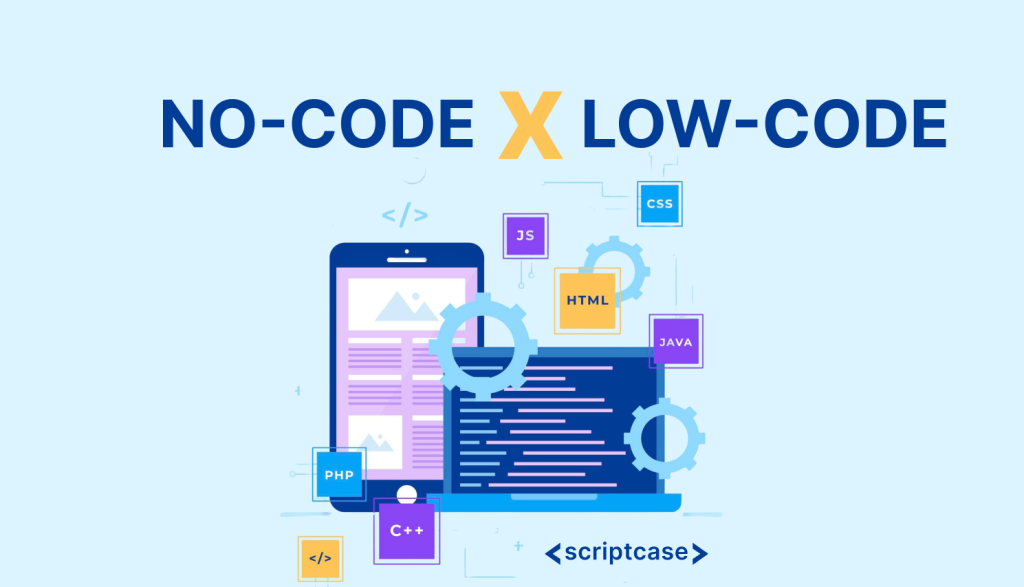With the popularization of No-code and Low-code platforms, application development has reached a point where even people without advanced technical knowledge can build digital solutions. However, despite the promise of ease and speed, it’s important to understand the limitations and when a minimum of coding is really necessary. In this article, we’ll demystify No-code, show the advantages of Low-code, and explore tools like Scriptcase to demonstrate the potential of minimal coding to strengthen business rules.

No-Code: Freedom or Hidden Limitations?
No-code platforms promise an intuitive and visual experience. They allow you to develop everything, from websites to applications and systems, without writing a single line of code—but does this solve everything? The answer is complex. While No-code facilitates the quick and affordable creation of prototypes or MVPs (minimum viable products), it also brings disadvantages that may compromise the project’s future. Let’s reflect on these points below:
Limited Customization: Since No-Code platforms don’t require any coding, they generally lack flexibility in fine-tuning functionalities. This means you might face issues when trying to adapt the tool to your business’s specific needs.
Platform Dependence: Using a No-Code solution means you must follow the rules and functionalities provided by the platform. When the software owner changes its business model or decides to shut down the service, it directly affects your project.
Scalability Issues: Often, a No-Code solution isn’t designed to handle large volumes of data or significant numbers of users, which may make it unsuitable for growing companies. The inability to keep pace with the company’s growth and needs can mean considerable rework and delays in evolving business goals.
Minimum Coding or Low-code: Now let’s talk about the Middle Ground that makes a difference!
Low-code combines the best of both worlds, offering simplicity in development and the flexibility of code. In practice, you’ll have a set of ready-made components but with full freedom to customize when necessary. It’s possible to meet specific business requirements without sacrificing scalability and security. Low-code is especially beneficial for companies that rely on some differentiation, allowing code to optimize processes or integrate various systems.
Advantages of Low-Code:
Customization and Flexibility: Low-code allows you to add customization layers that aren’t possible with No-code, adjusting resources according to business rules.
Integration with Other Systems: Unlike No-code, Low-code can integrate various platforms, creating a truly connected solution.
Scalability and Performance: Low-code platforms support advanced customization, allowing applications to grow with a business’s growth rate.
Scriptcase: An Example of Low-code
Among low-code platforms, Scriptcase stands out in providing functionality for efficient, agile web system development. It enables custom solution development with integrations with major databases: MySQL, MariaDB, PostgreSQL, SQLite, Interbase, SQL Azure, Amazon Aurora, Firebird, Access, Oracle, MS SQLServer, DB2, Sybase, Informix, or ODBC layer. Moreover, Scriptcase offers a user-friendly interface while developing robust web systems, allowing IT professionals to optimize the process without losing control.
Benefits of Using Scriptcase:
Speeds Up Development: Scriptcase offers functionalities to accelerate system development by automating form, report, and dashboard creation. Additionally, it has an intuitive interface, allowing developers to create complete modules with a few clicks, reducing manual coding time. Ideal for companies needing to present results quickly without compromising system quality.
Database Integration: One important advantage of Scriptcase is its ease of integration with various databases, such as MySQL, PostgreSQL, SQL Server, and Oracle. The platform enables simultaneous connections to multiple data sources, a prerogative for companies handling information from various sectors and systems. This flexibility is essential for consolidating information accessible at all organizational levels.
Customization and Flexibility: Although a Low-Code tool, Scriptcase allows developers to insert specific code in PHP, JavaScript, or HTML when needed, using its blank application feature. This is essential for companies aiming to adapt the system to their business rules, ensuring each functionality aligns with operational needs.
Advanced Security: Security is a strong point of the solution, enabling various authentication methods, access control, and user activity tracking. You can grant access to applications with specific rules to prevent unauthorized users from accessing information. This is crucial for companies in regulated industries or those handling sensitive data, such as finance or healthcare.
Mobile Device Support: Applications generated by Scriptcase are responsive and optimized for mobile devices. The automatic generation of adaptable layouts means the application interface will be visually appealing and useful on smartphones and tablets—a strategic advantage for companies needing mobility, as employees or clients can access the system from anywhere.
Cost and Resource Savings: Scriptcase saves time by avoiding complex and costly development and maintenance steps. The Low-Code model reduces the need for large developer teams, enabling small and medium-sized companies to implement a complete system.
Simplified Maintenance: Updates and maintenance are streamlined; the code is organized so that all changes, fixes, and improvements are applied much more easily than with other tools. This advantage is particularly significant for companies with dynamic demands and frequent application updates to stay competitive.
See also: Low-Code: The Key to Accessible Digital Transformation
Conclusion
No-code and Low-Code are user-friendly alternatives that speed up development, but understanding each approach’s pros and cons is essential. No-code can be highly accessible; however, for companies requiring greater flexibility and control, it may be restrictive. Low code, especially with tools like Scriptcase, allows companies to create scalable and customizable solutions to meet business demands and remain competitive with market demands.
No-Code or Low-Code must ultimately be implemented based on the business’s needs and long-term goals. After all, it should be an ally in growth, not an obstacle.
Still have questions? Dive deeper into the topic: Why Low-Code is Essential for Any Business?

You might also like…